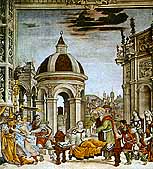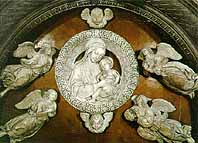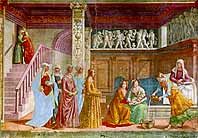
F.no Lippi, Drusiana's resurrection
Excusez nous mais cette page n'est pas été encore traduite en Français
The five chapels of the apse can be found from right to left in the following order in the transept.
The Bardi Chapel.
It contains remains of 13th century frescoes by the school of Cimabue and a painting by Vasari.
Strozzi Chapel.
From 1486 it was under the patronage of Filippo Strozzi the Elder who
decided to have the walls decorated with Stories of St. Philip and St.
John the Evangelist, giving the commission to Filippino Lippi. This is
one of the last works to be painted by this artist from Prato (1503),
already under the influence of the Mannerist school. Strozzi's tomb stands
at the rear of the chapel; it was sculpted by Benedetto da Maiano (1491-93),
who also designed Palazzo Strozzi (1437) for the same patron in the square
of the same name.

B.da
Maiano "Madonna del latte"
Curiously enough Giovanni Boccaccio staged the opening of his book "The Decameron" in this chapel. The author wrote that "seven young ladies habited sadly in keeping with the season...also of noble birth .... and three young men" met here during the plague of 1348.
The Tornabuoni Chapel (or of the high altar), dedicated to the Virgin
Mary.
It was under the patronage of the Tornabuoni family from 1485. A bronze
Crucifix by Giambologna is placed above the heavy marble altar
carried out during the mid 19th century restoration work. The apse contains
the choir-stalls and an inlaid lectern attributed to Baccio d'Agnolo. The chancel is particularly spectacular
thanks to the extensive cycle of frescoes depicting the Stories of the Virgin
(on the left), and St. John the Baptist (on the right), carried out between
1485 and 1490 by Domenico Ghirlandaio, his
brother Davide and several students, including Michelangelo.

Ghirlandaio, Birth of the virgin
This cycle, which replaced the frescoes by Orcagna, some of which can be seen today in the Museum, is one of Ghirlandaio's most important works and is also famous because it contains portraits of many of the well known personalities of Renaissance Florence.
The Gondi Chapel.
The first stone of the new Basilica was laid
here on October 18th 1279. The architectural decoration is the work of Giuliano
da Sangallo (1508). The ceiling shows the traces of some 13th century
frescoes, some of the oldest in Florence, and were possibly carried out
by the Byzantine masters who inspired Cimabue's
revolutionary change of style. The famous Crucifix in wood by Brunelleschi (1410-25)
is placed over the altar, the only piece of sculpture he is known to
have carried out; according to tradition he created it to compete with
Donatello's crucifix in Santa Croce.
The Gaddi Chapel.
It was carried out by architect Giovanni Antonio Dosio between 1575 and
1577 in imitation of the Diocletian Baths in Rome. A painting by Bronzino hangs
above the altar.
